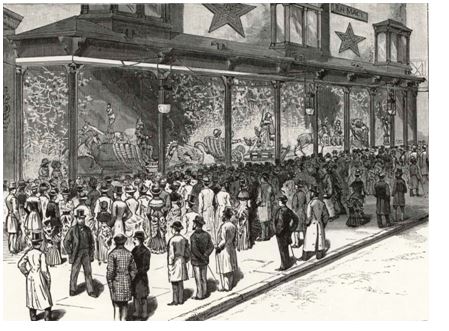Introduction
The American retail scene is characterized by cutthroat competition in virtually all niches. It calls for thoughtfully and creatively crafted merchandising strategies to gain a competitive edge. Retailers that have successfully differentiated themselves from their competitors have an upper hand in the market. A case in point is Macy’s, which is a leader in the American retail industry and is also one of the top performing retailers globally (Biesada par. 1).
This departmental store chain has been tremendously successful in its marketing endeavors. It successfully developed a range of private label brands, which are quite popular across America (Brown par. 11). Through its private label brands, Macy’s has successfully set itself apart as a retailer that has the interests of its customers at heart.
Consequently, the retailer has continued to display a dazzling performance over the years. Nevertheless, as is the norm with any business venture, the need to grow overrules everything else. Macy’s is not exemption to this norm. The retailer’s impressive past performance is no excuse for complacency. Consequently, this essay concerns itself with examining Macy’s current retail strategy and developing a new private label merchandise strategy on which the retailer can leverage its growth prospects for the future.
An overview of Macy’s History and its current Retail Strategy
What is currently known as Macy’s Inc. started as three different businesses in two different American towns at different times in the 1800s. In 1830, John Shillito started a retail business in New York and named it Shillito’s (“History of Federated, Macy’s” par. 1). He later changed the name to Federated. In 1858, Rowland Hussey Macy started a retail business in Cincinnati, Ohio and named it R.H. Macy & Co (“History of Federated, Macy’s” par. 1).
Like Shillito, he later changed the name of the business to Macy’s. In 1872, the Bloomingdale brothers, Joseph and Lyman, started a business in New York and named it Bloomingdale’s (“History of Federated, Macy’s” par. 2). These three organizations grew separately for some time and in 1930, Bloomingdale’s was acquired by Federated. Many years later, in 1994, Federated once again acquired Macy’s. Each of the retailers kept their names after joining Federated.
Instead, it was Federated that changed its name to Macy’s Inc. Therefore, at the moment, Macy’s is one of the subsidiaries of Macy’s Inc., which is a multinational corporation that also owns Bloomingdale’s. Macy’s is thus an American departmental store chain, which is by far, the largest retailer in the U.S. It specializes in the retail of apparel, women’s accessories, shoes, cosmetics as well as home furnishes such as furniture and housewares (Brown 36). The retailer operates about 840 stores across the United States, Puerto Rico, and Guam (Biesada par. 1).
Its ability to grow to its current status was as a result of the retailer’s creativity coupled with its down to earth approach in handling customers. Macy’s pulled a number of remarkable surprises, which bolstered its endeavors to emerge as a formidable player in the American retail industry.
In 1862, the retailer created plentiful buzz during the holiday season by coming up with the idea of an in-store Santa Clause. Two years later, Macy’s became the first retailer to develop impressive window displays that allowed customers to view merchandise from outside the store.

The year 1902 saw the retailer make yet another bold move, by moving to the Herald Square building, which was a 19-storey building with up to 33 elevators and 4 escalators.

After 22 years, the retailer once again did what it was known for. It came up with the idea of the Thanks Giving Parade. And later in 1976, Macy’s crafted the idea of the Annual Flower Shower. Several other ideas that pass as norms in the contemporary retail scene are attributable to Macy’s.
The steps outlined above were not meant to just impress customers, but to help the retailer connect with them and understand their needs and expectations. They clearly set Macy’s apart as a retailer that believed firmly in robust marketing strategies. When it later merged with Federated, Macy’s became unstoppable because the two were a perfect match.
The former’s extensive market reach and the latter’s creative marketing skills were perfectly complementary. The merger gave Macy’s an impetus to grow even faster while simultaneously developing new ideas that have continued to guide its marketing to date.
The marketing strategies employed by Macy’s are characterized by a deep understanding of its customers and their needs. For example, the retailer understands that Americans value quality and in response, it offers a collection of top notch fashion brands such as Ralph Lauren, Marc Jacobs, Calvin Klein and Donna Karen (Biesada par. 6).
These are brands that target its high-end customers. In addition to these brands, Macy’s has developed its own private label brands for most of these popular national brands. The private label brands are meant to cater for customers who seek quality products, but are conscious of value. Macy’s private label brands include Alfani, I.N.C., American Rag and Charter Club (Biesada par. 7). The American public has grown to embrace them just like the major fashion brand offerings.
To make its private label brands noticeable, Macy’s ensures that they are displayed adjacent to the fashion brands that they closely resemble. With this arrangement, the customer can compare prices and as well as quality and decide whether to go for the fashion brand or the private label brand.
Macy’s took its customer oriented approach a step further by coming up with some creative marketing strategies. Firstly, it studies the tastes and preferences of the customers in the locality of each store and provides exactly what they need. As such, its stores vary in the quantity and variety of stock held depending on the needs of a particular locality (Schulz par. 39).
Secondly, the retailer employs an Omni-channel approach to its retailing. It addition to its stores, it has an online platform, which allows customers to order a product even if it is not available in the nearby store. The online platform also includes mobile device retailing.
Thirdly, Macy’s came up with a creative marketing idea in which its frontline store attendants are required to Meet and make a connection with the customer, Ask questions and listen, Give options and advice, Inspire to buy and Celebrate the purchase (Schulz par. 40). The capitalized words in this strategy form the word MAGIC. Thus MAGIC is an acronym for Macy’s selling strategy. Through these techniques and others that were mentioned earlier, the retailer has been able to perform exceptionally well in the United States.
An Idea for Future Growth and Advancement of Private Label Brands
After a careful study of the marketing techniques used by Macy’s and its strong connection with its customers, it becomes apparent that the organization has for a long time limited its own growth by confining itself to the U.S. market. Bloomingdale’s, its sister retailer under the banner of Macy’s Inc. has gone far ahead by venturing into the international market and is performing considerably well (Loeb par. 1).
Important to note is that although Macy’s still operates in the U.S. only, it is the highest revenue earner for Macy’s Inc. In fact, as previously indicated, Federated changed its name to Macy’s Inc. due to the strength of the Macy’s brand. It is a brand that is well known across the world in the retail industry.
My suggestion is that since Macy’s has successfully projected itself as a mid-range retailer, which is capable of bringing high quality products to the customer at relatively low prices, it is time it seriously considered venturing into middle income markets. At the moment, middle income states such as Brazil, India, Argentina and Russia among numerous others are taking the world by a storm due to their increasing importance in the global economy.
As of 2013, the population of the middle income world stood at close to five billion (“Middle Income Countries” par. 1). As such, although they are also home to a big percentage of the world’s poor people, these countries have middle class and high class populations that outnumber the American population by far. In fact, not all Americans purchase their clothing and accessories from Macy’s, yet the retailer has been able to post the impressive performance it is known for.
Plans of going international are already underway at Macy’s. However, the retailer plans to open its first store in the United Arab Emirates (UAE) (Loeb par. 1). This move clearly shows that even though it is moving outside the U.S., it is still targeting a high income market. The UAE has in recent years emerged as a leading tourist destination and shopping hub, but such attributes are nothing compared to the over one billion potential customers that the middle income world has to offer.
Therefore, first step in actualizing this plan will be to engage in extensive research to determine the viability of setting up at least one store in each of the major cities of the middle income countries. Since it is known for its great ability to understand its customers and adapt its merchandise to the locality in which it operates, Macy’s will be able to fit in perfectly with the tastes and preferences of the people in these countries. In addition, globalization has made the world increasingly aware of global fashion and trends.
As such, what trends in America can easily trend in any other part of the world. The retailer should take advantage of the idea that most people around the globe, especially in the middle and low income world consider what is good in America to the best the world can offer.
The second step in this plan will be to identify the people it will sell its merchandise to. As noted earlier, the middle income world has a growing middle class population as well as a sizeable high class population. Macy’s should target these two groups right from their young ones to adults.
Class matters are very important in these countries and anything that is considered as belonging to the high class can be an instant attraction if packaged well and marketed effectively. The retailer should avoid shunning these markets and be the risk taker it was when it was trying to make itself known across America. The middle class and high class populations of these countries are capable of affording its merchandise. They just need to be convinced that Macy’s is the way to go.
Finally, Macy’s will need to develop a marketing strategy that will enable it to take hold of the market in these countries. To begin with, its marketing strategies such as MAGIC selling and Omni-channel marketing can go a long way in helping it make inroads into the new markets because internet penetration continues to grow tremendously in these countries. In addition, Macy’s can make use of the concept of celebrity endorsement.
This concept is relatively old, but the retailer can still capitalize on it by seeking the assistance of global celebrities who are loved in the various countries. Local celebrities can also be featured endorsing the retailer’s private label brands. When the public gets to know that their beloved celebrities wear Macy’s private label brands, they will go for the same brands and Macy’s might be surprised to witness a phenomenon such as those it witnesses in its U.S. stores during peak seasons.

This way, Macy’s can use the private label brands it has worked so hard to build to bolster its future growth prospects unprecedentedly.
Conclusion
Macy’s has proven itself to be a creative and highly effective retailer. This creativity has won the hearts of Americans, causing them to embrace its private label brands without prejudice. This pattern can be replicated elsewhere. As such, Macy’s should desist from shunning perceived low income markets because such markets have sizeable middle and high income populations that can bolster its growth in the future.
Works Cited
Biesada, A. “Macy’s, Inc.: Cincinnati, OH United States.” Hoover’s, Inc. Web.
Brown, R. “The Magic of Macys.” Display & Design Ideas 21.3 (2009): 36. MasterFILE Premier. Web.
“History of Federated, Macy’s.” Daily News (New York) 2005. LexisNexis Academic. Web.
”Middle Income Countries.” The World Bank Group. Web.
Loeb, W. “Why Macy’s Is Finally Expanding Globally.” Forbes 2014. Web.
Schulz, David P. “Top 100 Retailers.” National Retail Federation 2014. Web.